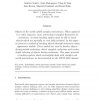127
Voted
ICIP
2009
IEEE
14 years 10 months ago
2009
IEEE
This paper presents a low-cost tracking algorithm based on multiple multiple fragments, increasing robustness with respect to partial occlusions. Given the initial template repres...
119
click to vote
IVC
2006
15 years 28 days ago
2006
Objects in the world exhibit complex interactions. When captured in a video sequence, some interactions manifest themselves as occlusions. A visual tracking system must be able to...
126
click to vote
DAGM
2001
Springer
15 years 5 months ago
2001
Springer
Vision systems for service robotics applications have to cope with varying environmental conditions, partial occlusions, complex backgrounds and a large number of distractors (clut...
129
click to vote
ISMAR
2002
IEEE
15 years 5 months ago
2002
IEEE
Pattern-based augmented reality systems are considered the most promising approach for accurately registering virtual objects with real-time video feeds. The problem with existing...
119
click to vote
ACCV
2006
Springer
15 years 7 months ago
2006
Springer
Tracking of regions and object boundaries in an image sequence is a well studied problem in image processing and computer vision. So far, numerous approaches tracking different fea...
ICIP
2008
IEEE
15 years 7 months ago
2008
IEEE
In this paper, we present a new solution to the problem of matching tracking sequences across different cameras. Unlike snapshot-based appearance matching which matches objects by...
130
click to vote
FGR
2008
IEEE
15 years 7 months ago
2008
IEEE
Partial occlusions in face images pose a great problem for most face recognition algorithms. Several solutions to this problem have been proposed over the years – ranging from d...
118
Voted
ICPR
2006
IEEE
16 years 2 months ago
2006
IEEE
Varying illumination and partial occlusion are two main difficulties in visual tracking. Existing methods based on appearance information cannot solve these problems effectively s...
121
click to vote
ECCV
2008
Springer
16 years 2 months ago
2008
Springer
Abstract. Recently, impressive results have been reported for the detection of objects in challenging real-world scenes. Interestingly however, the underlying models vary greatly e...
105
click to vote
ICCV
2007
IEEE
16 years 2 months ago
2007
IEEE
In this paper we investigate physics-based plane beam model, frequently used in mechanical and civil engineering, to track large non-linear deformations in images. Such models do ...

